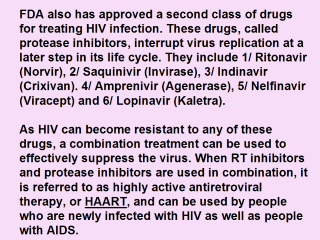| front |1 |2 |3 |4 |5 |6 |7 |8 |9 |10 |11 |12 |13 |14 |15 |16 |17 |18 |19 |20 |21 |22 |23 |24 |25 |26 |27 |28 |29 |30 |31 |32 |33 |34 |35 |36 |37 |review |
 |
Researchers
have credited HAART as being a major factor in significantly reducing the
number of deaths from AIDS in this country. While HAART is not a cure for
AIDS, it has greatly improved the health of many people with AIDS. It
reduces the amount of virus circulating in the blood to nearly undetectable
levels. Researchers, however, have shown that HIV remains present in hiding
places, such as the lymph nodes, brain, testes and retina of the eye, in
patients who have been treated.
Despite the beneficial effects of HAART, there are side effects associated with the use of antiviral drugs that can be severe. Some of the nucleoside RT inhibitors may cause a decrease of red or white blood cells, especially when taken in the late stages of disease. Some may also cause inflammation of the pancreas and painful nerve damage. Some of the antiretroviral nucleoside analogs when used alone or in combination have caused severe reactions. Therefore, people on antiretroviral therapy should be routinely seen and followed by their health care providers. The most common side effects associated with protease inhibitors include nausea, diarrhea and other gastrointestinal symptoms. In addition, protease inhibitors can interact with other drugs resulting in serious side effects. |